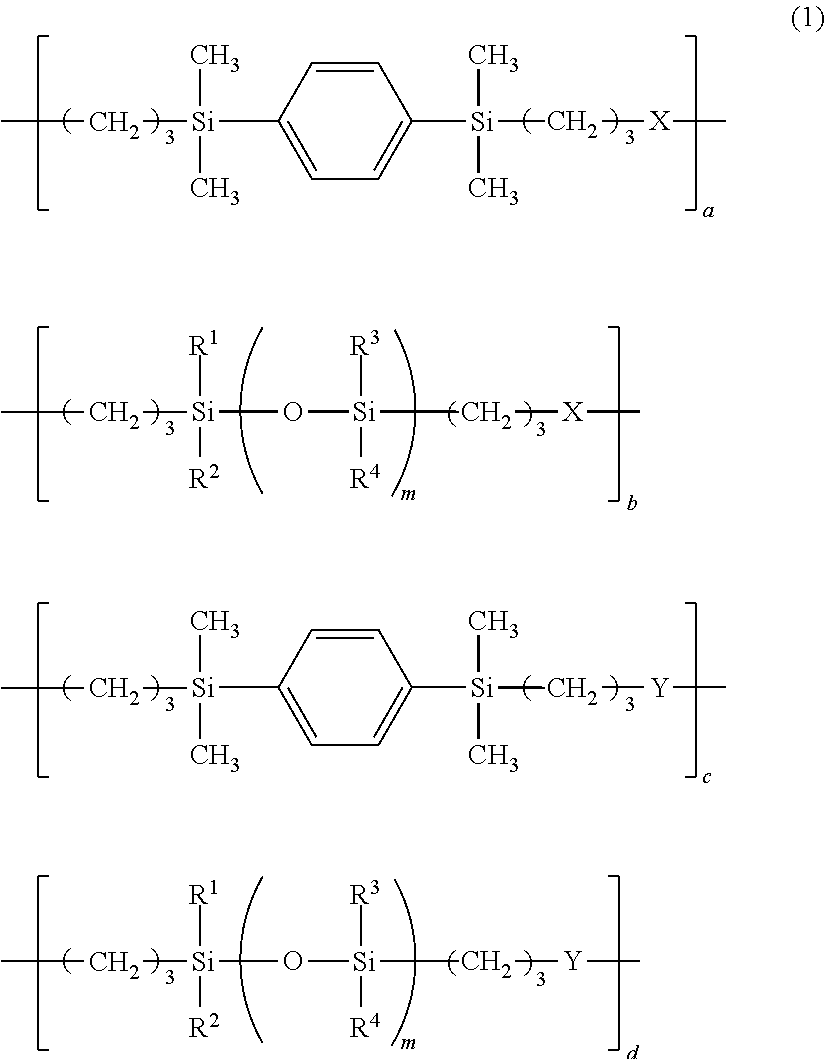Photocurable dry film, method for preparing same, patterning method and film for protecting electric and electronic parts
a technology of dry film and photocurable film, which is applied in the direction of textiles and paper, solid-state devices, and recording information storage, etc., can solve the problems of insatiable solution of flatness and step coverage, difficulty in substantially uniform coating of substrate, and difference in height, etc., to achieve excellent heat resistance, chemical resistance, insulating property and flexibility
- Summary
- Abstract
- Description
- Claims
- Application Information
AI Technical Summary
Benefits of technology
Problems solved by technology
Method used
Image
Examples
synthetic example 1
[0264]396.5 g of compound (M-1) was dissolved in 1,668 g of toluene in a 5 liter flask equipped with an agitator, a thermometer, a nitrogen purge device and a reflux condenser, followed by further addition of 859.2 g of compound (M-4) and heating to 60° C. Thereafter, 2.2 g of a platinum on carbon catalyst (5 wt %) was charged, and after confirmation of an internal reaction temperature raised to 65 to 67° C., the reaction solution was further heated to 90° C. for three hours and cooled down to 60° C., followed by charging 2.2 g of a platinum on carbon catalyst (5 wt %) and dropping 78.3 g of compound (M-5) in the flask in one hour. At this stage, the temperature in the flask was raised up to 79° C. After completion of the dropping, the reaction solution was aged at 90° C. for three hours and cooled down to room temperature, to which 1,550 g of methyl isobutyl ketone was added, followed by subjecting the reaction solution to pressure filtration with a filter to remove the platinum ca...
synthetic example 2
[0265]352.8 g of compound (M-1) and 90.0 g of compound (M-3) were dissolved in 1,875 g of toluene in a 5 liter flask equipped with an agitator, a thermometer, a nitrogen purge device and a reflux condenser, followed by further addition of 949.6 g of compound (M-4) and 6.1 g of compound (M-5) and heating to 60° C. Thereafter, 2.2 g of a platinum on carbon catalyst (5 wt %) was charged, and after confirmation of an internal reaction temperature raised to 65 to 67° C., the reaction solution was further heated to 90° C. for three hours and cooled down to 60° C., followed by charging 2.2 g of a platinum on carbon catalyst (5 wt %) and dropping 107.3 g of compound (M-6) in the flask in one hour. At this stage, the temperature in the flask was raised up to 79° C. After completion of the dropping, the reaction solution was aged at 90° C. for three hours and cooled down to room temperature, to which 1,700 g of methyl isobutyl ketone was added, followed by subjecting the reaction solution to ...
synthetic example 3
[0266]352.8 g of compound (M-1) and 116.1 g of compound (M-2) were dissolved in 1,875 g of toluene in a 5 liter flask equipped with an agitator, a thermometer, a nitrogen purge device and a reflux condenser, followed by further addition of 949.6 g of compound (M-4) and 6.1 g of compound (M-5) and heating to 60° C. Thereafter, 2.2 g of a platinum on carbon catalyst (5 wt %) was charged, and after confirmation of an internal reaction temperature raised to 65 to 67° C., the reaction solution was further heated to 90° C. for three hours and cooled down to 60° C., followed by charging 2.2 g of a platinum on carbon catalyst (5 wt %) and dropping 107.3 g of compound (M-6) in the flask in one hour. At this stage, the temperature in the flask was raised up to 73° C. After completion of the dropping, the reaction solution was aged at 90° C. for three hours and cooled down to room temperature, to which 1,700 g of methyl isobutyl ketone was added, followed by subjecting the reaction solution to...
PUM
| Property | Measurement | Unit |
|---|---|---|
| Temperature | aaaaa | aaaaa |
| Temperature | aaaaa | aaaaa |
| Length | aaaaa | aaaaa |
Abstract
Description
Claims
Application Information
 Login to View More
Login to View More - R&D
- Intellectual Property
- Life Sciences
- Materials
- Tech Scout
- Unparalleled Data Quality
- Higher Quality Content
- 60% Fewer Hallucinations
Browse by: Latest US Patents, China's latest patents, Technical Efficacy Thesaurus, Application Domain, Technology Topic, Popular Technical Reports.
© 2025 PatSnap. All rights reserved.Legal|Privacy policy|Modern Slavery Act Transparency Statement|Sitemap|About US| Contact US: help@patsnap.com



